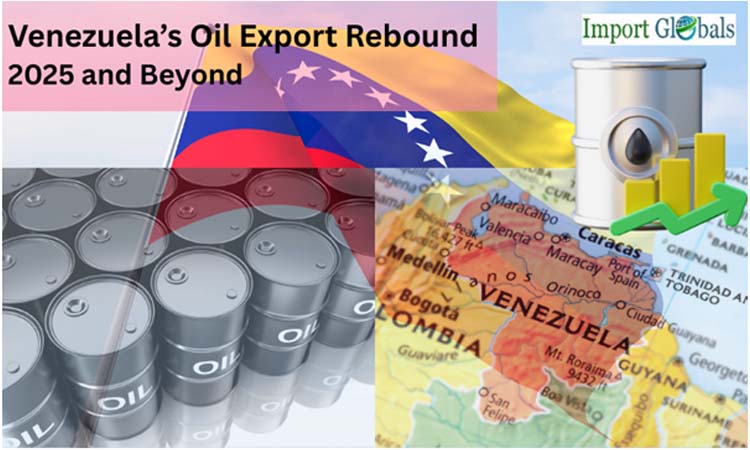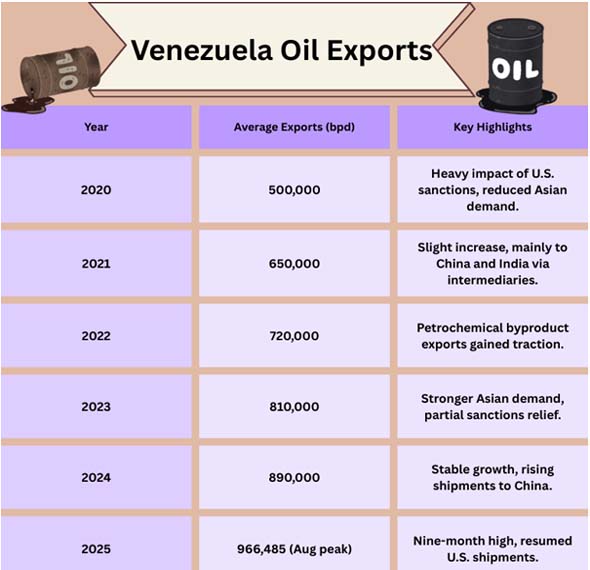
- Oct 24, 2025
Venezuela’s Oil Export Rebound: 2025 and Beyond
Venezuela has the largest known deposits of crude oil in the world; therefore, its economy has historically depended on exporting oil. The country started to improve in 2025 after years of sanctions, bad infrastructure, and changing levels of production.
According to Import Globals Venezuela Import Data, Venezuela's oil exports averaged 966,485 barrels per day (bpd) in August 2025, the highest level in nine months. The key reasons for this recovery were resuming shipments to the US, robust demand from China, and steady rises in sales of petrochemicals and byproducts. The recent rise in exports has been a major turning point for Venezuela's economy and its role in the world's energy markets.
Venezuela's Oil Exports in 2025
Venezuela's oil exports have been up and down for most of the previous 10 years because of international sanctions, a lack of investment, and old oil infrastructure. According to Import Globals' Asia Export Data, the country did better in 2025 when it had tighter trade ties with Asian markets, and the U.S. lifted some of its restrictions for a short time. Exports hit their highest level in almost a year in August 2025 alone. Some of the main contributors were:
Cargo traveling to the US, especially Chevron's legal, approved flows of around 60,000 barrels per day.
China, which bought roughly 85% of Venezuela's crude oil exports, was the main buyer.
Exporting petrochemicals and their byproducts brings in more money.
This comeback not only stabilizes the economy, but it also puts Venezuela at the forefront of the world's crude oil markets.

Main Places to Export
China is the Biggest Customer and one of the Major Places where Goods are Sent
According to Import Globals' China Import Export Trade Data, China still buys the most Venezuelan oil, making up about 85% of total imports. Chinese refineries like Venezuelan heavy crude better since it costs less, and they may pay for it in different ways, such as through barter and loan repayments. Venezuela has been able to keep up its export levels despite international sanctions because of this link.
The United States: A Cautious Return
After years of restricted direct exports, Venezuelan oil was carefully brought back into U.S. refineries in 2025. According to USA Import Data from Import Globals, Chevron started importing oil under specified agreements and is already processing about 60,000 barrels per day. Costs are lower now than they were before the penalties. This shows that Washington has a good plan to make the energy business more reliable.
People from Asia, like India, Buy
India used to buy a lot of oil from Venezuela, but in the last few years, it has cut back on its imports because it is worried about getting in trouble. Import Globals' study on India's import trade suggests that Singapore and Malaysia are actively shipping and mixing Venezuelan oil for export.
What are Petrochemicals and Byproducts, and what is their Role
Venezuela has been exporting more amount of fuel oil, petrochemicals, and other byproducts abroad, along with crude oil. Venezuela Export Data shows that these exports have helped make up for part of the money lost since there were fewer crude oil exports in the past.
Venezuela import trade analysis shows that these exports have helped make up for part of the money lost since there were fewer crude oil exports in the past. Exports of byproducts brought in around 15% of all hydrocarbon income in 2025. This enabled PDVSA, the state-owned oil firm, to find new methods to earn money.
The implications for Venezuela's Economy
Venezuela's Economy is Greatly Affected by the Surge in Oil Exports:
Import Globals has USA Import Data that shows how much money they make from foreign exchange. Oil money is still the country's principal source of hard cash, which helps maintain its foreign reserves from running out.
Fiscal Stability: PDVSA's finances improve as exports rise, which allows them to put some money back into infrastructure.
Controlling Inflation: A larger export industry helps keep the value of money steady and avoids hyperinflation.
Trade Balance: Venezuela's trade imbalance gets smaller as it sells more, which makes it simpler for other nations to get involved.
But things are still hard! The infrastructure is still outdated, corruption is still getting in the way of PDVSA's job, and the sanctions relief won't last long.
What does this Signify for the Oil Markets throughout the World?
The oil markets throughout the world are affected by Venezuela's return to oil exports. The US is less powerful in Venezuela because it provides more commodities to China. China has more power there. Import Globals' USA Import Trade Statistics say that the small amount of Venezuelan oil that flows back to the US gives American refiners more areas to get oil.
This new scenario makes Venezuela a major energy partner and a tool for negotiating in the world of politics. If Venezuela's production keeps rising like this, then it might stabilize the worldwide supply. Especially in times of tensions in the Middle East and changing dynamics of OPEC+ output choices.
What to Look Forward to in the Near Future
Three key factors will determine how well Venezuela's Exports Fare in the Future:
Sanctions Policy: The US will determine whether to make sanctions stronger or last longer. This might make it hard for individuals to get into Western markets.
Chinese Demand: Import Globals looked at China Import Data and found that Venezuela's exports are closely linked to Asia's energy demands since Venezuela depends so heavily on Chinese imports.
Investing in Infrastructure: To keep up with development, refineries, pipelines, and drilling capacity need to be improved.
Venezuela's exports might reach their highest level in more than 10 years by the end of 2025, with an average of more than 1 million barrels per day.
In short,
Venezuela's oil exports went up again in August 2025. This signifies that the country's energy business is both powerful and weak. The economy will benefit from the boost to roughly 966,500 bpd, but the country is still dependent on changes in geopolitics and difficulties with its infrastructure. The U.S. is steadily becoming a popular destination again, but China is still the biggest buyer. In the future, Venezuela's involvement in the global energy market will depend on finding a balance between lifting sanctions, making investments, and forming strategic relationships. Import Globals is a leading data provider of Venezuela Import Export Trade Data. To know more about global trade, sign up for Import Globals today only!
FAQs
Que. What does Venezuela sell the most of?
Ans. According to Venezuela Export Import Global Trade Data, crude oil is Venezuela's biggest export, making up more than 90% of all export income.
Que. What country buys the most oil from Venezuela?
Ans. China is the main buyer of crude oil from Venezuela, buying around 85% of it in 2025.
Que. Is the U.S. buying Venezuelan oil again?
Ans. Yes, Chevron started bringing in around 60,000 barrels a day again in 2025, but only under certain conditions.
Que. What issues does Venezuela face in maintaining its oil exports?
Ans. Some of the biggest problems include old infrastructure, corruption in PDVSA, and not knowing what the U.S. sanctions policy would be.
Que: Where can I find a full Venezuela Import Export Trade Analysis?
Ans. Visit www.importglobals.com or email info@importglobals.com for more information about current data.
